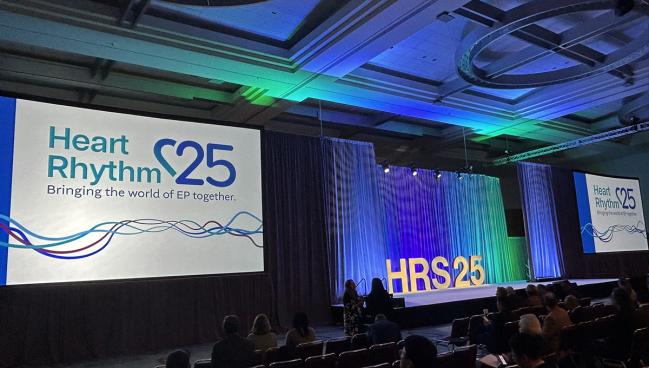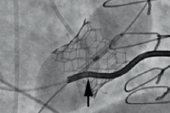Pairing CIED Lead Extraction With Tricuspid Interventions Appears Safe
Complications weren’t more common when leads were extracted. Yet there’s also the option of “jailing” leads instead.

SAN DIEGO, CA—Among patients with cardiac implantable electronic devices (CIEDs) undergoing tricuspid valve interventions, performing concurrent lead extraction does not appear to carry excess risks, a study of Medicare beneficiaries indicates.
Patients who had their leads removed did not have significantly higher rates of in-hospital complications, with the exception of acute kidney injury not requiring hemodialysis (adjusted OR 1.5; 95% CI 1.2-1.9).
Enrico Ferro, MD (Beth Israel Deaconess Medical Center, Boston, MA), who reported the findings reported here at Heart Rhythm 2025, suggested that difference could be related to end-organ damage stemming from concurrent endocarditis, the main indication for extraction.
“Our study shows that for patients—ideally who have a clinical indication, say endocarditis—lead extraction together with valve intervention does not seem to disproportionately increase the complication rates,” Ferro told TCTMD.
He underscored the importance of studying this issue. “Patients with preexisting leads are a sizable minority of the tricuspid valve intervention population, and they tend to be sicker,” he said, noting that patients with tricuspid valve disease tend to have high complication rates to begin with. “So we need to be careful and we need to continue accumulating evidence to decide how to manage them. Should we jail the leads? Should we extract the leads? And who should benefit from either intervention?”
There’s not much in the literature to inform these decisions, Ferro said. Some reports suggest that jailing the lead—trapping it between the prosthetic device and the native ring of the tricuspid valve—results in a malfunction rate of about 10% over a year of follow-up. “And that’s problematic if you’re dependent on pacing or if you need those shocks—if you have a ventricular tachycardia and other pathologies,” he said.
On the other hand, lead extraction carries its own risks, including up to a 1% risk of death and a 3-5% risk of serious complications, Ferro noted. “So just adopting a blanket approach where you always extract or you always jail doesn’t seem to be an easy decision to make.”
The current study explored the impact of performing lead extraction alongside a tricuspid valve intervention. Using Medicare data, the investigators identified 25,910 patients who underwent a percutaneous or surgical tricuspid intervention between 2016 and 2023, of whom 9.2% had a preexisting CIED. Patients with an implanted device (mean age 71.6 years; 50.1% women) had a higher comorbidity burden than those without a CIED (mean age 71.4 years; 55.3% women).
In the CIED cohort, 82.1% underwent surgery for the tricuspid intervention and 17.9% had a percutaneous procedure, although the proportion of surgical interventions declined by about 4.4% per year and the proportion of percutaneous procedures increased by about 4.5% per year over the course of the study.
Ferro noted that for most of the study period, the Evoque device (Edwards Lifesciences) for transcatheter tricuspid valve replacement (TTVR) and the TriClip device (Abbott) for tricuspid transcatheter edge-to-edge repair (T-TEER) were not in use, so the shift toward percutaneous procedures is likely to accelerate moving forward.
Of the patients with a CIED, 18.9% underwent their tricuspid intervention combined with lead extraction (within 30 days of the procedure), while the leads remained in place for the other 81.1%. Having a clinical indication for extraction—endocarditis and lead malfunction were the top two—was the strongest predictor of having the leads removed, whereas older age, a higher comorbidity burden, and having a leadless CIED were associated with a lower likelihood of extraction.
“All of this suggests that, currently, operators are really thinking about who should undergo extraction and they’re trying to avoid the higher-risk patients,” Ferro said.
Aside from acute kidney injury, none of the in-hospital complications examined—including death, acute respiratory failure, major or minor bleeding, cardiac arrest, decompensated heart failure, pericardial effusion, pneumothorax, and stroke/TIA—occurred at higher rates in patients with CIEDs who did versus did not undergo extraction.
“The bottom line is that we did not find a significant increase in complications when the extraction is done on top of a valvular intervention,” Ferro said, noting that, overall, “the rate of complications in absolute terms was actually pretty high.”
To follow up on these findings, Ferro’s team will conduct another analysis to examine what happens when CIED leads are jailed during tricuspid interventions, he said. “Because that comes with its own risk of a series of complications, such as lead malfunction.” Those findings, he added, “will give us the other half of the story.”
Exploring these questions is critical, he said, because patients with CIEDs in the current study were 1.73 times more likely to undergo a percutaneous intervention rather than surgery. With both TriClip and Evoque gaining US Food and Drug Administration approval last year, use of transcatheter devices to treat tricuspid valve disease is expected to increase exponentially.
“It makes it even more relevant to study these patients,” Ferro said.
Todd Neale is the Associate News Editor for TCTMD and a Senior Medical Journalist. He got his start in journalism at …
Read Full BioSources
Ferro EG. Practice patterns and clinical outcomes for tricuspid valve interventions among Medicare patients with cardiac implantable electronic devices in the United States. Presented at: HRS 2025. April 26, 2025. San Diego, CA.
Disclosures
- Ferro reports no relevant conflicts of interest.





Comments